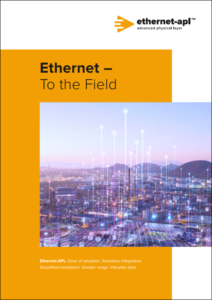
 Abstract
Abstract
“Process plants operate for 20+ years and are required to be safe for people, the product, and the environment. Explosion potential in hazardous areas and harsh conditions require that any deployment of new technology is both thoroughly tested and provides added business benefits. Technology must not be complicated in handling or require extensive training. Ethernet is the de-facto communication standard in enterprises, but it does not meet the requirements in the field of process automation without modification. Ethernet with an Advanced Physical Layer (Ethernet-APL) will enable long cable lengths and explosion protection via intrinsic safety with communication and power over two wires. Based on IEEE and IEC standards, Ethernet-APL supports any Ethernet-based automation protocol and will develop into a single, long-term stable technology for the entire process automation community. This white paper covers the business environment, technical specifications, implications for different user types, and the development status of Ethernet-APL.”
Situation and Business Environment for Process Applications
“Leading suppliers to process automation recognize the need from their customers to add the universality and communication speed of standard Ethernet to existing field device installations. Ethernet has been deployed at the upper levels of the automation pyramid and in the field with 4-wire Ethernet devices, such as drives, flow, analyzers and motor control centers. However, it requires enhancements to support applications in the field of process plants.”
“A key group of these leading suppliers and standards development organizations have come together with the goal of accelerating development and adopting a new open standard for an Ethernet physical layer for the use in process automation and instrumentation that can be deployed in hazardous areas, allow long-reach connectivity, and include an option for device power over the line. This new Ethernet advanced physical layer, called “Ethernet-APL,” together with the automation protocols that define the structure and meaning of information being transmitted to and from field devices, will be one of the key enabling factors of the IIoT in process automation. It will provide a vital prerequisite to extend the digitized world to process automation and instrumentation.”
